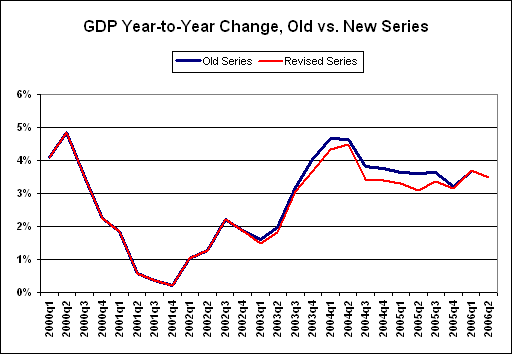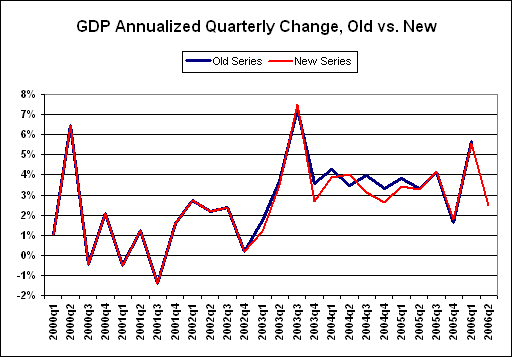Alert
A L E R T
July 29, 2006
__________
GDP Manipulation
Second-Quarter GDP Contracted 0.5% Net of Unusual Inflation Gimmicks
2003 to 2005 GDP Growth Restated with Broad Downward Revisions
__________
Planned initially as a Flash Update -- designed to cover regular results from economic reporting discussed in the newsletter -- this brief commentary has been upgraded to an Alert because of the unusually-overt manipulation of second-quarter GDP reporting. -- John Williams
The "advance" estimate of annualized seasonally-adjusted real (inflation-adjusted) growth in second-quarter 2006 Gross Domestic Product (GDP) was reported at a below-consensus 2.5%, down from the first quarter's unrevised 5.6%. Due to an unconscionable manipulation of the inflation data, those results masked a quarterly contraction that likely was in excess of 0.5%. A contraction would be consistent with the current, though officially unrecognized, recession. Please note that this contraction is before any adjustment for the upside methodological biases built into existing GDP reporting.
As discussed in the July 17th SGS, a quarterly contraction in second-quarter inflation-adjusted retail sales growth was going to make it difficult for the Bureau of Economic Analysis to come up with positive GDP growth in the second quarter. The gimmick used to produce the 2.5% gain (still shy of a 3.0% consensus expectation) was an old one, an understatement in quarterly inflation used for deflating the GDP number.
In theory, GDP growth first is estimated in current dollars and then deflated for inflation effects. In reality, the needed politically-correct real growth rate appears to be determined first, with the needed deflation rate a residual factor that rarely has any relationship to reality.
If the GDP inflation rate (implicit price deflator) is understated, real GDP growth is overstated by a like amount. The just-published data show both the annualized first- and second-quarter deflation rates to be identical, at 3.3%.
In contrast, the annualized first- and second-quarter seasonally-adjusted CPI inflation rates were 2.2% and 5.0%, respectively, a quarterly surge of 2.8% in annualized inflation. While there are serious problems with CPI understatement, and the CPI is narrower in scope than the GDP deflator, the GDP deflator generally should move in tandem with the CPI.
Given the structural differences between the GDP and CPI universes, the indication from the CPI reporting is that the second-quarter GDP deflator should have been in excess of 6.3%. That difference not only would have resulted in a GDP contraction greater than 0.5%, but also could have done serious damage to the bond market and expectations of Mr. Bernanke's next action.
As expected, previously reported GDP growth was revised downwardly throughout the 2003 to 2005 period. Not surprisingly, most of the revisions were tied to partially correcting previously understated GDP deflation. As to total GDP level at year-end 2005, the downward revision was 0.3% before inflation, 0.8% after inflation. By year, annual average growth rates were reduced from 2.7% to 2.5% for 2003, from 4.2% to 3.9% for 2004 and from 3.5% to 3.2% for 2005. Growth still remains seriously overstated.
Most components of GDP growth deteriorated in revision, except for the gimmicked improvement in the services sector of the trade deficit, as discussed in the June 12th Alert. The biggest area of correction was in business investment in computers. Such is both surprising and encouraging, because the broad under-deflation of computer sales as been one of the larger methodological distortions in historic GDP reporting.


The above graphs detail the net annual and quarterly revisions. Further details will follow in the regular August SGS.
August's "Shadow Government Statistics" is scheduled for release on Wednesday, August 18, 2006. The posting of the next SGS, as well as any Flash Updates or Alerts, will be advised immediately by e-mail.